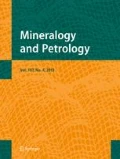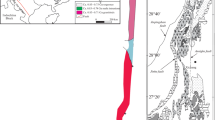Abstract
High Mg-Al granulite occurs as enclave within granite gneisses at Karimnagar, southern India, and it contains coarse granoblastic aggregates of orthopyroxene and sapphirine with minor amount of cordierite, spinel and phlogopite. An important chemical characteristic of these minerals is their extremely high MgO content and the high Cr2O3 in sapphirine and spinel. Textural analysis shows sapphirine + orthopyroxene + cordierite as the peak-metamorphic assemblage that possibly evolved though the breakdown of a spinel-bearing assemblage. Cation exchange geothermometers involving orthopyroxene, sapphirine and spinel yield temperatures of 600–800 °C with a maximum of 860 °C implying an event of high temperature (HT) metamorphism. Pseudosection analysis in the FeO–MgO–Al2O3–SiO2 chemical system shows the stability of the peak- assemblage below 6.2 kbar. Subsequently, the rock underwent hydration and cooling with the appearance of phlogopite in the assemblage. Chromium enrichment is possibly inherited from the protolith and its presence presumably stabilized sapphirine and spinel below their high-temperature stability field. The recorded Rb–Sr age of ca. 2,500 Ma in host granite gneiss marks the upper age limit of HT metamorphism. Presence of patchy, lobate grains as well as veinlets of uraninite and brannerite is also a characteristic feature of the rock. Uranium mineralization took place during the post peak metamorphic stage, sulfide mineralization represented by tiny grains and veinlets of pyrite, millerite and pentlandite coincided with, and outlasted the uranium mineralization. The U–Th–Pb chemical ages of uraninite grains suggest ca. 2,200 ± 12 Ma for the age of uranium mineralization in the granulite. Based on the field relations, it is surmised that the granulite metamorphism in the study area is older than ca. 2,500 Ma and is comparable with an event in the other parts of Eastern Dharwar Craton. It can be conceived as a widespread event in southern India.










Similar content being viewed by others
References
Acharyya SK (1997) Evolutionary characters of the Gondwanic Indian crust. Ind Miner 51:1–24
Acharyya SK (2000) Comment on “Crustal structure based on gravity-magnetic modeling constrained from seismic studies under Lambert rift, Antarctica and Godavari and Mahanadi rifts, India and their interrelationship”: by Mishra DC. Earth Planet Sci Lett 179:595–598
Andreoli MAG, Hart RJ (1990) Metasomatized granulites and eclogites of the Mozambique belt: implications for mantle devolatilization. In: Herbert HK, Ho SE (eds) Proceedings of the Conference on Stable Isotopes and Fluid Processes in Mineralization, vol 23. University of Western Australia, Geology Department & University Extension Publication, Nedlands, Australia, pp 121–140
Andreoli MAG, Hart RJ, Ashwal LD, Coetzee H (2006) Correlations between U, Th content and metamorphic grade in the Western Namaqualand Belt, South Africa, with implications for radioactive heating of the crust. J Petrol 47:1095–1118
Bernard-Griffiths J, Fourcade S, Kienast J-R, Peucat J-J, Martineau F, Rahmani A (1996) Geochemistry and isotope (Sr, Nd, O) study of Al-Mg granulites from the In Ouzzal Archean block (Hoggar, Algeria). J Metamorph Geol 14:709–724
Bowels JFW (1990) Age dating of individual grains of uraninite in rocks from electron microprobe analyses. Chem Geol 83:47–53
Boynton WV (1984) Geochemistry of the rare earth elements: meteorite studies. In: Henderson P (ed) Rare Earth element geochemistry. Elsevier, Amsterdam, The Netherlands, pp 63–144
Brigida C, Poli S, Valle M (2007) High-temperature phase relations and topological constraints in the quaternary system MgO–Al2O3–SiO2–Cr2O3: an experimental study. Am Mineral 92:735–747
Connolly JAD, Petrini K (2002) An automated strategy for calculation of phase diagram sections and retrieval of rock properties as a function of physical conditions. J Metamorph Geol 20:697–708
Crawford AR (1969) Reconnaissance Rb–Sr dating of Precambrian rocks of southern peninsular India. J Geol Soc India 10:117–166
Das K, Bose S, Fujino K (2005) Reappraisal of Fe and Mg partitioning between coexisting spinel solid solution and cordierite: geothermometric formulation from experimental data and its application to natural occurrences. Spec Commem Vol Indian J Geol 85:135–146
Das K, Fujino K, Tomioka N, Mirua H (2006) Experimental data on Fe and Mg partitioning between coexisting sapphirine and spinel: an empirical geothermometer and its application. Eur J Mineral 18:49–58
Donohue CL, Essene EJ (2005) Granulite-facies conditions preserved in Vanadium and Chromium-rich metapelites from the Paradise Basin, Wind River Range, Wyoming, USA. Can Mineral 43:495–511
Friend CRL (1982) Al–Cr substitution in peraluminous sapphirines from the BjØrnesund area, Fiskenaesset region, southern West Greenland. Mineral Mag 46:323–328
Friend CRL, Hughes DJ (1977) Archaean aluminous ultrabasic rocks with primary igneous textures from the Fiskenaesset region, southern West Greenland. Earth Planet Sci Lett 36:157–167
Fritsche R, Dahlkamp FJ (1997) Contribution to characteristics of uranium oxides. In: Assessment of uranium deposit types and resources- a worldwide perspective. Proc Tech Comm Meeting, IAEA and OECD Nuclear Energy Agency, Vienna, 253 pp
Gasparik T (1994) A petrogenetic grid for the system MgO–Al2O3–SiO2. J Geol 102:97–109
Govindraju K (1994) Compilation of working values and sample description of 383 geostandards. Geostand Newslett, (special issue). J Geostand Geoanalysis 18:1–18
Grant JA (1968) Partial melting of common rocks as a possible source of cordierite-anthophyllite bearing assemblages. Am J Sci 266:908–931
Graterol M, Naldrett AJ (1971) Mineralogy of the Marbridge No. 3 & No. 4 nickel-iron sulfide deposits; with some comments on low temperature equilibration in the Fe–Ni–S system. Econ Geol 66:886–900
Harley SL (1993) Sapphirine granulites from the Vestfold Hills, East Antarctica: geochemical and metamorphic evolution. Antarct Sci 5:389–402
Harley SL (2008) Refining the P-T records of UHT crustal metamorphism. J Metamorph Geol 26:125–154
Harley SL, Christy AG (1995) Titanium-bearing sapphirine in a partially melted aluminous granulite xenolith, Vestfold Hills, Antarctica–geological and mineralogical implications. Eur J Mineral 7:637–653
Heinrich E (1958) Mineralogy and geology of radioactive raw materials. McGraw Hill, New York, 149 pp
Henry DJ, Guidotti CV, Thompson JA (2005) The Ti-saturation surface for low- to-medium pressure metapelitic biotites: implications for geothermometry and Ti-substitution mechanisms. Am Mineral 90:316–328
Hensen BJ (1986) Theoretical phase relations involving garnet and cordierite revisited: the influence of oxygen fugacity on the stability of sapphirine and spinel in the system Mg–Fe–Al–Si–O. Contrib Mineral Petrol 92:362–367
Holland TJB, Powell R (1998) An internally consistent thermodynamic data set for phases of petrological interest. J Metamorph Geol 16:309–343
Holland TJB, Powell R (2003) Activity-composition relations for phases in petrological calculations: an asymmetric multicomponent formulation. Contrib Mineral Petrol 145:492–501
Jayananda M, Banerjee M, Pant NC, Dasgupta S, Kano T, Mahesha N, Mahableswar B (2012) 2.62 Ga high-temperature metamorphism in the central part of the Eastern Dharwar Craton: implications for late Archaean tectonothermal history. Geol J 47:213–236
Kamineni DC, Rao AT (1988) Sapphirine granulites from the Kakanuru area, Eastern Ghats, India. Am Mineral 73:692–700
Kato T, Suzuki K, Adachi M (1999) The computer program for the CHIME age calculation. J Earth Planet Sci Nagoya Univ 46:49–56
Kawasaki T, Sato K (2002) Experimental study of Fe–Mg exchange reaction between orthopyroxene and sapphirine and its calibration as a geothermometer. Gondwana Res 5:741–747
Kemp U (2003) Precise electron microprobe age determination in altered uraninite: consequences on the intrusion age and the metallogenic significance of the Kirchberg granite Erzgebirge, Germany. Contrib Mineral Petrol 145:107–118
Kramers JD, Reassign K, Jones MQW (2001) Crustal heat production and style of metamorphism: a comparison between two Archaean high-grade provinces in the Limpopo belt, southern Africa. Precambrian Res 112:149–163
Mishra DC, Sekhar DVC, Raju DCV, Kumar V (1999) Crustal structure based on gravity-magnetic modeling constrained from seismic studies under Lambert rift, Antarctica and Godavari and Mahanadi rifts, India and their interrelationship. Earth Planet Sci Lett 172:287–300
Misra K, Fleet ME (1973) The chemical composition of synthetic and natural pentlandite assemblages. Econ Geol 68:518–539
Moine B, Sauvan P, Jarousse J (1981) Geochemistry of evaporate-bearing series: a tentative guide for the identification of metaevaporites. Contrib Mineral Petrol 76:401–412
Naldrett AJ, Craig JR, Kullerud G (1967) The central portion of the Fe–Ni–S system and its bearing on pentlandite solid solution in iron-nickel sulfide ores. Econ Geol 62:826–847
Owen JV, Greenough JD (1991) An empirical sapphirine-spinel Mg–Fe exchange thermometer and its application to high grade xenoliths in the Popes Harbour dyke, Nova Scotia, Canada. Lithos 26:317–332
Pandey BK, Prasad RN, Sastry DVLN, Kumar BRM, Rao SS, Gupta JN (1988) Rb–Sr whole rock ages for the granites from parts of Andhra Pradesh and Karnataka. Fourth NSMS, Indian Institute of Sciences, Bangalore, India (Preprint volume), p EPS-3/1-5
Pandey BK, Gupta JN, Sharma KJ, Sastry CA (1997) Sm–Nd, Pb–Pb and Rb–Sr geochronology and petrogenesis of mafic dyke swarm of Mahbubnagar, South India: implications for Palaeoproterozoic crustal evolution of Eastern Dharwar craton. Precambrian Res 84:181–196
Raghavan V (2004) Fe–Ni–S (Iron–Nickel–Sulfur). J Phase Equilib 25:373–381
Rajagopalan V, Paul AK (2011) Role of analytical mineralogy of major primary uranium and thorium minerals in atomic mineral exploration in India. Thematic volume (Published by Elsevier) evolved from the Proceedings of International Conference (IAEA-DAE) on Peaceful Uses of Atomic energy-2009. Resources, New Delhi, pp 67–76
Rajesham T, Bhaskara Rao YJ, Murti KS (1993) The Karimnagar granulite terrane: a new sapphirine-bearing granulite province, South India. J Geol Soc India 41:51–59
Rollinson HR (1993) Using geochemical data; evaluation, presentation, interpretation. Longman, Harlow, Essex, UK, 352 pp
Santosh M, Yokoyama K, Acharyya SK (2004) Geochronology and tectonic evolution of Karimnagar and Bhopalpatnam granulite belts, central India. Gondwana Res 7:501–518
Sharma IN, Prakash D (2006) Occurrence of kornerupine-bearing granulite from Karimnagar, Andhra Pradesh. Curr Sci 91:678–683
Singh Y, Singh KDP, Prasad RN (2004) Rb-Sr whole rock isochron age of early Proterozoic potassic granite from Dharmavaram, Karimnagar district, A.P. J Geol Soc India 64:93–96
Som A, Saibaba M, Jeyagopal AV, Sobhita K, Mohanty R, Maithani PB (2010) Occurrence of uranium in metasedimentary enclaves within basement granite, near Peddur and Kottur, Karimnagar district, Andhra Pradesh. J Geol Soc India 76:247–250
Taylor SR, McLennan SM (1985) The continental crust: its composition and evolution. Blackwell, Oxford, 312 pp
Vielzeuf D (1983) The spinel and quartz association in high grade xenoliths from Tallante (S.E. Spain) and their potential use in geothermometry and barometry. Contrib Mineral Petrol 82:301–311
Vielzeuf D, Clemens JD, Pin C, Moinet E (1990) Granites, granulites, and crustal evolution. In: Vielzeuf D, Vidal Ph (eds) Granulites and crustal evolution. NATO ASI Series, Kluwer, Dordrecht, The Netherlands, pp 59–85
Warren RG (1979) Volcanogenic and sedimentary origins to the sapphirine-bearing rocks in the Arunta Block, central Australia. Nature 278:159–161
Wood DA, Joron JL, Treuil M, Norry M, Tarney J (1979) Elemental and Sr isotope variations in basic lavas from Iceland and the surrounding ocean floor. Contrib Mineral Petrol 70:319–339
Yoshida M, Bindu RS, Kagami H, Rajesham T, Santosh M, Shirahata H (1996) Geochronologic constraints of granulite terranes of South India and their implications for the Precambrian assembly of Gondwana. J SE Asian Earth Sci 14:137–147
Acknowledgments
The authors are thankful to Director, AMD, for giving permission to publish this research article. SB and KD acknowledge the DST FIST-sponsored research laboratory facilities at the Presidency University, Kolkata and Bengal Engineering and Science University, Shibpur, respectively. AC thankfully acknowledges Department of Atomic Energy for Raja Ramanna Fellowship grant. We thank Dr. Subrata Karmakar for his help and suggestions, particularly those related to the geochronological calculations. SB thanks Saptarshi Mallick for his assistance. J.G. Raith, Editor in Chief, and two anonymous reviewers are thanked for their thoughtful comments on the manuscripts. These comments immensely helped to improve the quality of this paper.
Author information
Authors and Affiliations
Corresponding author
Additional information
Editorial handling: K. Stüwe
Rights and permissions
About this article
Cite this article
Sarbajna, C., Bose, S., Rajagopalan, V. et al. U–Cr-rich high Mg-Al granulites from Karimnagar Granulite Belt, India: implications for Neoarchean-Paleoproterozoic events in southern India. Miner Petrol 107, 553–571 (2013). https://doi.org/10.1007/s00710-012-0242-6
Received:
Accepted:
Published:
Issue Date:
DOI: https://doi.org/10.1007/s00710-012-0242-6



